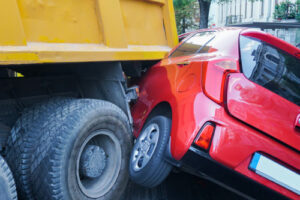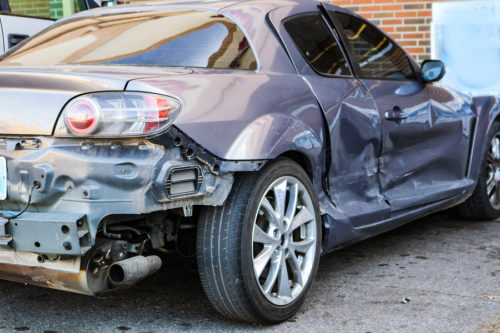When on the road, you usually expect a vehicle collision to come from in front of you or behind. You might even plan for a vehicle to sail through an intersection, T-boning your car. Many drivers, however, fail to adequately prepare for the possibility of a sideswipe collision.
Prepared or not, sideswipe collisions can occur in the blink of an eye, often leaving victims with serious injuries.
What Is a Sideswipe Collision?
Sideswipe collisions occur when one car swipes the side of another vehicle, either traveling in the same direction or going in opposite directions. They can occur for a variety of reasons:
- Distracted driving. Distracted drivers, including those who text and drive, often drift outside their lanes. If another vehicle occupies the space in the lane they drift into, distracted drivers can cause a sideswipe collision.
- Driving erratically. Some drivers in a rush may change lanes abruptly, trying to get to their destination faster. In many cases, this can prevent drivers from seeing vehicles in the other lane until they pull over on top of them. Fast lane changes can quickly lead to sideswipe collisions.
- Speeding. Driving at a high rate of speed can make it more difficult for many drivers to control their vehicles. At high rates of speed, drivers may slip out of their lanes in a turn, leading to sideswipe collisions.
- Merging. As a driver merges into traffic, he must yield to oncoming traffic, fitting his vehicle into the empty space between other cars. Unfortunately, many drivers fail to safely yield as they pull onto highways and interstates. Failure to yield can lead to a sideswipe collision when the oncoming driver cannot move out of the way.
- Driving under the influence. Driving under the influence of drugs or alcohol can leave many drivers struggling to control their vehicles. Driving while impaired may result in slipping out of the correct lane or bumping into another vehicle, often at a high rate of speed. Impaired drivers may fail to properly recognize lane designations or drive erratically, increasing the risk of many types of collisions, including sideswipe collisions.
- Driving drowsy. Like driving under the influence, drowsy driving can cause drivers to fail to properly note lane designations. Drowsy drivers may drift off behind the wheel and fail to note turns in the road. If the car pulls to one side of the other, if the driver nods off behind the wheel, even for a moment, the car may naturally pull into another lane of traffic.
- Over-correction. Many young drivers, in particular, may struggle to know how to handle a vehicle when they must turn abruptly. Slipping off the road for a moment can cause even experienced drivers to jerk the wheel back, causing them to cross into another lane of traffic as they attempt to correct a mistake. When the other lane of traffic contains another vehicle, it can result in a sideswipe collision.
- Big trucks and other high-clearance vehicles. Some people also refer to sideswipe collisions as blind spot accidents, since they often occur when a driver fails to notice a car in his blind spot. Blind spot collisions grow more likely when a high-clearance vehicle or one with a large blind spot changes lanes without the driver looking carefully for another vehicle. Sideswipe accidents involving big trucks and their large blind spots can cause substantial damage to the other vehicle and its passengers, especially on the side that gets hit.
- Road rage. Raging drivers often commit highly illogical acts or deliberately cause accidents, including sideswipe collisions, to “punish” the other driver or “teach him a lesson.” During a road rage event, the raging driver may deliberately ram his vehicle into another car from the side, causing a sideswipe collision.
Common Sideswipe Collision Injuries
Sideswipe collisions can cause a wide range of injuries, especially in passengers on the side of the vehicle impacted by the collision. Sideswipe accidents can scrape paint and break mirrors. At high rates of speed, especially if the sideswipe occurs against oncoming traffic, they can crumple in door panels and even remove them altogether. Common injuries include:
Amputations
Victims on the side of the vehicle impacted by a sideswipe collision can lose limbs in the blink of an eye: either during the accident itself, the limb ripped off as the vehicle scrapes past, or after the accident, when doctors cannot repair crushing damage to the limb or the limb went without blood flow for so long that the tissue begins to necrotize. The initial cost of amputation can range between $30,000 and $60,000, with increased costs for treatment over the next several years. While some victims may need only a single surgery, others may need future revisions to the amputated limb to improve the fit of a prosthesis or remove further damaged tissue as the full extent of the injury grows clearer after the initial accident.
Amputation represents a lifelong expense for many victims: an average prosthetic can cost between $5,000 and $50,000, depending on the technology used and the type of amputation. Victims often must replace prosthetic limbs every 3-5 years—and replacement may occur much more frequently for athletes, victims in demanding professions, or those who have trouble getting a good fit.
Broken Bones
Like amputations, broken bones occur frequently during sideswipe collisions. An average broken limb that does not require surgical intervention to set can cost the patient around $2,500. More severe breaks, on the other hand, may require surgery, hospitalization, and extensive physical therapy to recover as much mobility as possible. Many victims of sideswipe collisions suffer multiple broken bones on the same side of the body, making mobility a bigger problem during the recovery process. Broken bones sometimes cause ongoing pain and difficulty for victims long after the initial accident.
Spinal Cord Damage
Severe sideswipe collisions can put a great deal of force on the spine of the victim. Even spinal cord damage that causes only minor loss of mobility can cost nearly $350,000 for the initial treatment and recovery process. Victims who suffer more serious injuries, including complete paralysis below the site of the injury, may have ongoing medical costs for the rest of their lives: paraplegia, or paralysis below the waist, can cost nearly $69,000 per year, while tetraplegia can cost an average of $113,000 to $185,000, depending on the location of the break.
Traumatic Brain Injury
Traumatic brain injury occurs as the victim’s brain hits the side of the skull with extreme force, which may occur during a sideswipe collision. Any trauma to the head can lead to traumatic brain injury. If the victim loses consciousness at the scene, he should always seek medical treatment to rule out or identify traumatic brain injury. Lifetime treatment for a patient with a traumatic brain injury can range from $85,000 to $3 million. Some victims with traumatic brain injuries cannot return to work or their normal lives after the injury due to trouble with comprehension or impulse control. Others may need constant supervision to keep them out of danger.
Avoiding Sideswipe Collisions

Even the safest driver cannot always predict accident risk and prevent an accident ahead of time. You can, however, do several things to decrease your risk of a sideswipe collision.
1. Check your blind spot carefully before changing lanes.
Every time you change lanes, carefully check your blind spot to ensure another car has not slipped into it while your attention drifted elsewhere. You may also want to carefully watch the flow of traffic while you drive, identifying other drivers in your mirrors and keeping track of them when you know you have a lane change approaching.
2. Keep an eye on big trucks and high-clearance vehicles.
While the drivers of larger vehicles, including semi trucks, sit high off the road to help improve visibility, they still have large blind spots that can contribute to accident risk. When you travel beside big trucks and high-clearance vehicles, try to stay out of their blind spots, even if that means increasing or decreasing your speed to travel in a safer location. If you notice a large vehicle signaling that it plans to change lanes into a lane you occupy, tap your horn and try to get out of the way if you can do so safely.
3. Merge with care.
Merging causes drivers to need to look in several directions at once. Merging onto busy roads, in particular, can make it difficult to find exactly the perfect place to slip into traffic. When you need to merge, make sure you have adequate room to pull your vehicle into traffic to complete the maneuver. If you notice another driver trying to merge, try to get your vehicle out of the way, whether that means speeding up to give more room or dropping your speed to allow that driver into traffic.
4. Avoid distracted, intoxicated, or drowsy driving.
As a driver, you need to stay alert at all times behind the wheel. Your primary responsibility remains driving your vehicle safely, not checking your phone for text messages, eating, carrying on a conversation, or adjusting the temperature in the car. Keep your eyes and attention on the road when you get behind the wheel. If you have had too many drinks, call a designated driver or use Uber, Lyft, or a taxi service to provide a sober ride. By exercising a few simple safety precautions, you can keep yourself and others on the road safer.
5. Closely watch other drivers.
Any time you share the road with other vehicles, especially in tight traffic, watch other drivers carefully. If you notice drivers behaving erratically, swerving, or driving while distracted, try to stay out of their way. If needed, pull off the road and give dangerous drivers time to pass by to help decrease your likelihood of an accident.
6. Have a plan in place to get out of the way.
When you find yourself in tight traffic, make sure you have a plan to get out of the way if another driver comes close enough to sideswipe your vehicle. Develop a habit of questioning what other drivers might do, even if the other driver handles his vehicle perfectly. Consider how you might handle the potential for a collision if another driver starts to drift into your lane or abruptly pulls over in front of you. If you do not have adequate room to maneuver or to avoid an accident, you may want to change your location on the road or your speed to help keep yourself and your passengers safer. When you develop the habit of considering where you need to go if you notice the potential for an accident, you increase the odds that you will prepare yourself if a driver does not behave as expected.
7. Report erratic drivers.
If you notice another driver behaving erratically, especially traveling at excessively high speeds or swerving into other lanes of traffic, pull off of the road safely and report them. Getting off the road can prevent you from suffering serious injuries in an accident, and reporting the driver to the police can help stop other drivers from getting hurt.
8. Avoid road rage.
You know that avoiding raging yourself can help you avoid many types of accidents. If you notice another driver giving in to road rage, get out of the way. Do not engage with the other driver, including yelling back or using rude hand gestures. By keeping your cool, you can often decrease the odds that the other driver will take out that rage on you.

Sideswipe collisions can cause serious injuries and damage to both drivers and vehicles, especially on the side of the car that gets hit. If you suffered injuries in a sideswipe collision, an experienced automobile accident attorney can help you understand your car accident claim and start seeking the compensation you deserve.

